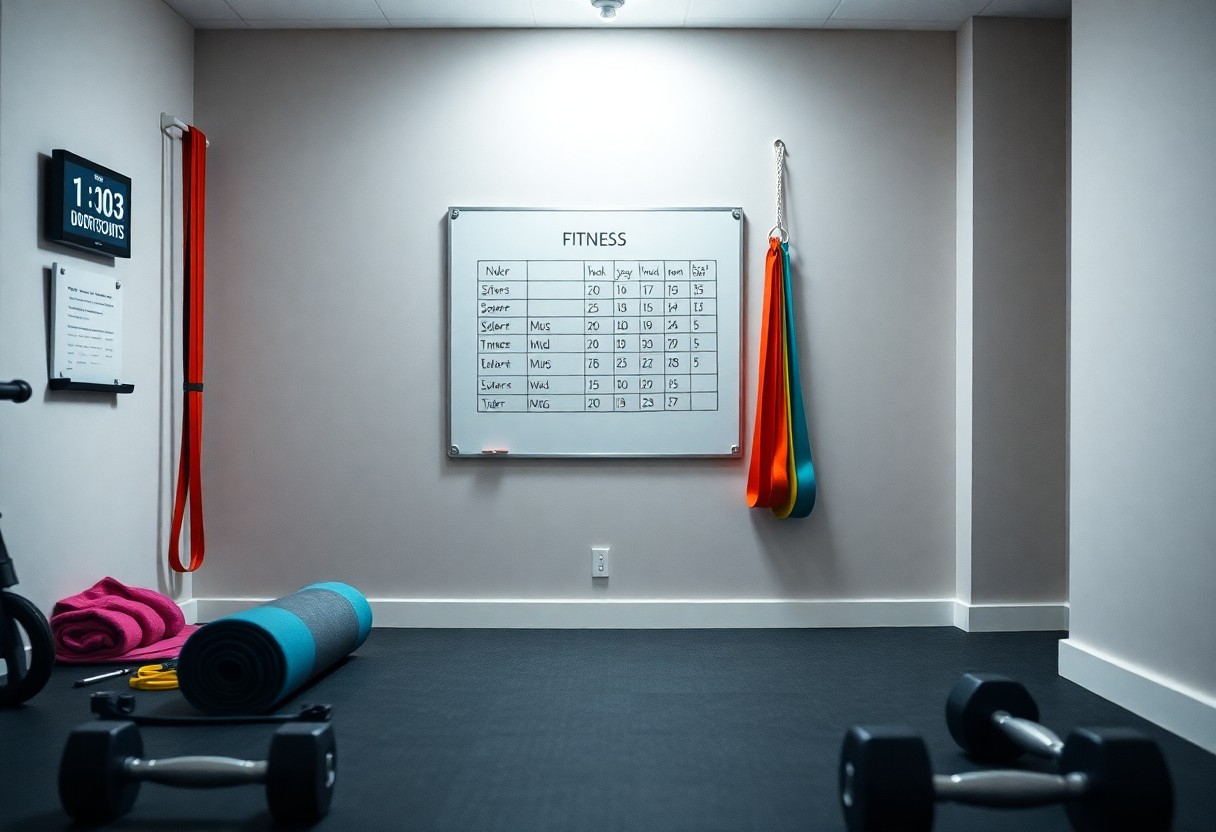This guide offers practical strategies to help you maintain discipline in your fitness journey, especially when your motivation dips. You will learn how to set achievable goals, establish a consistent routine, and harness the power of accountability to keep pushing forward. With these techniques, you can transform your focus from fleeting motivation to sustainable habits that lead to long-term success. Embrace the principles of discipline, and you will see positive results even on days when your drive feels low.

Key Takeaways:
- Establish a consistent routine to create habits.
- Set specific, measurable, achievable, relevant, and time-bound (SMART) goals.
- Track progress regularly to maintain accountability.
- Find an exercise buddy or community for support and encouragement.
- Adjust your goals and strategies to prevent burnout.
- Focus on the intrinsic benefits of fitness rather than external rewards.
- Prioritize rest and recovery to sustain long-term commitment.
Understanding the Importance of Discipline
Discipline acts as the backbone of your fitness journey, ensuring consistent progress even as motivation wanes. It involves sticking to your workout and nutrition plans, prioritizing health over momentary desires. Establishing a disciplined routine transforms your goals from dreams into tangible achievements, creating a sense of accountability that results in long-term success.
Defining Discipline in Fitness
Discipline in fitness means consistently adhering to your workout and dietary plans, regardless of external circumstances. It requires a commitment to maintain your focus and effort over time. This steadfastness ensures you prioritize your health, leading to significant improvements in strength, endurance, and overall well-being.
The Role of Habit Formation
Habit formation is integral to maintaining discipline in your fitness routine. By creating and sticking to healthy habits, you minimize the reliance on fleeting motivation. Studies suggest that developing a habit can take 21 to 66 days, depending on the complexity, making repetition important for success.
Forming habits is about integrating fitness into your daily life seamlessly. Start with small, manageable actions, such as scheduling workouts at the same time every day. As these behaviors become routine, they require less conscious effort. Over time, this transition from deliberate practice to automatic action fosters a lifestyle where exercising and eating well feels natural. Setting specific, measurable goals can also enhance habit formation, as you track progress and celebrate small victories, reinforcing your commitment to a healthier you.

Recognizing Motivation Dips
Understanding the fluctuations in your motivation can clarify your path forward. Motivation isn’t a constant; it ebbs and flows based on various factors. Recognizing these dips equips you to navigate through challenging moments without losing sight of your fitness goals. Your ability to acknowledge these phases is important for maintaining discipline and driving you back toward your objectives.
Common Causes of Motivation Fading
Various factors can lead to a decline in motivation, including burnout, lack of visible progress, or life changes such as increased responsibilities. External stressors, whether from work or personal life, can also sap your enthusiasm for fitness. Even routine workouts can become stale, resulting in diminished excitement and drive.
Signs That You Need to Reassess Your Goals
If you find yourself consistently skipping workouts, experiencing increased fatigue around fitness activities, or feeling bored with your routines, it may be time to reassess your goals. A lack of enthusiasm or difficulty visualizing success can indicate misalignment with your current targets. Paying attention to these signs helps ensure that your goals remain relevant and attainable.
Feeling disengaged from your workouts can signal a need for change. For example, if you’re no longer enjoying activities that once excited you or if your progress has stalled, those are strong indicators that your current goals may not resonate with your evolving interests or lifestyle. Consider re-evaluating your objectives: perhaps your goal is too ambitious, or you haven’t set achievable milestones. Adjusting your targets based on your current circumstances can reignite your motivation and set you back on a productive path toward fitness success.

Strategies to Maintain Discipline
Discipline in fitness arises from practical strategies that keep you accountable and committed. Relying solely on motivation can lead to inconsistency; instead, focus on specific practices that will reinforce your dedication over time. Adopting methods such as goal setting, structured schedules, and regular self-assessments will help you navigate the inevitable dips in motivation and stay aligned with your fitness aspirations.
Setting Realistic and Achievable Goals
Establishing realistic and achievable goals is vital for long-term success. Instead of aiming for dramatic transformations, focus on incremental changes that are manageable. For instance, setting a goal to exercise three times a week for 30 minutes builds a foundation you can gradually expand. This approach enhances your sense of accomplishment and keeps frustration at bay.
Creating a Structured Workout Schedule
A structured workout schedule transforms your fitness routine into a consistent pattern, making workouts a part of your daily life. Block out specific times in your calendar just as you would for important meetings. Use technology, like fitness apps or reminders, to hold yourself accountable. Commit to a variety of activities throughout the week to maintain interest and prevent burnout, ensuring everything from strength training to cardio fits seamlessly into your organized framework.
Leveraging Support Systems
Building a support system transforms your fitness journey. Engaging with others who share similar goals not only provides motivation but also fosters a sense of community. Surrounding yourself with supportive individuals can create an environment where consistency thrives, making it easier to focus on your objectives even when motivation wanes.
The Importance of Accountability Partners
Having an accountability partner significantly enhances your commitment to fitness goals. This individual encourages you to stay on track, celebrates your victories, and challenges you to push through obstacles. Regular check-ins with your partner create a sense of responsibility, making it less likely for you to skip workouts or abandon your plans.
Utilizing Fitness Communities and Resources
Joining fitness communities, whether online or in-person, expands your resources and motivation. These groups offer a wealth of knowledge, shared experiences, and collective encouragement that can reignite your passion for fitness. By participating in discussions or attending events, you gain insight into new workouts, nutrition tips, and success stories that resonate with your own goals.
Participating in fitness communities allows you to connect with like-minded individuals who share your aspirations. For instance, platforms like Strava or local running clubs provide both virtual and in-person opportunities for collaboration, competition, and support. Engaging in community challenges or group workouts makes the process enjoyable while holding you accountable. Resources like guided workouts, forums, or group classes ensure you have access to diverse fitness approaches that fit your personal style, ultimately keeping your discipline intact.
Incorporating Variety into Your Routine
Introducing variety into your fitness routine keeps things fresh and engaging, preventing boredom and burnout. Explore new activities, try different class formats, or alternate your workouts to surprise your body and mind. This approach facilitates continual progress while sustaining your enthusiasm, making it easier to stick with your goals.
Exploring Different Workout Types
To enhance your fitness journey, experiment with various workout types that suit your preferences and skills. Engaging in a mix of cardio, strength training, yoga, and high-intensity interval training (HIIT) can keep your routine exciting. Here are some examples:
- Running – Great for cardio endurance.
- Weightlifting – Builds muscle strength.
- Pilates – Increases flexibility and core strength.
- Cycling – Low-impact cardiovascular workout.
- Dance classes – Fun way to enhance coordination.
The results can lead to a more fulfilling fitness experience.
Setting Mini-Challenges for Engagement
Implementing mini-challenges adds a layer of excitement to your fitness routine, pushing you to achieve specific goals within a set timeframe. These challenges can include completing a certain number of push-ups each week, training for a 5K, or mastering a new yoga pose. By creating actionable and attainable goals, you transform your workouts into dynamic missions that keep you motivated.
Setting mini-challenges can stimulate your progress, as they encourage you to focus on short-term objectives while ultimately contributing to your long-term fitness journey. For example, challenge yourself to increase weights weekly, complete 100 lunges in a month, or engage in a daily 10-minute stretch routine. Keeping these challenges varied and exciting increases accountability, enhances your results, and helps sustain motivation. As you celebrate small victories, you reinforce positive behaviors that lead to significant changes over time.
Monitoring Progress and Celebrating Success
Regularly assessing your achievements fosters a sense of accomplishment, boosting your resolve to remain disciplined. Tracking metrics like workout frequency, endurance levels, or weight loss not only highlights your advancements but also identifies areas for improvement. Celebrating these victories reinforces your commitment and reminds you of your progress, making it easier to stay disciplined even when motivation wavers.
Tracking Your Fitness Journey
Documenting your workouts and dietary habits offers a concrete way to visualize your progress. Use apps or journals to log daily activities, noting improvements in lifting weights, running times, or flexibility. This data serves as a motivational tool; seeing tangible results reinforces your efforts, allowing you to adjust goals based on your performance.
Rewarding Yourself for Milestones
Recognizing your achievements with appropriate rewards can greatly enhance motivation. Whether it’s treating yourself to new workout gear or enjoying a spa day after reaching a specific fitness goal, rewarding milestones reinforces positive behavior. Celebrating these successes can keep you enthusiastic about your journey.
Setting specific rewards tied to your milestones is an effective strategy to maintain motivation. For instance, after losing the first 10 pounds or completing a challenging fitness program, consider investing in a quality pair of running shoes or a massage session. Make sure the rewards are meaningful to you, which will create a positive association with your accomplishments and encourage continued effort toward your fitness goals.
Conclusion
Ultimately, staying disciplined with your fitness goals when motivation wanes requires commitment to your routine, goal-setting, and accountability. Establish a structured schedule that includes specific, measurable targets, and track your progress regularly. Incorporate variety to keep your workouts engaging, and find a supportive community or partner to encourage your journey. Create an environment that fosters discipline, such as having workout gear ready and minimizing distractions. By focusing on consistency and your personal values, you can achieve lasting results even when motivation is low.
FAQ
Q: How can I set realistic fitness goals?
A: Setting SMART goals (Specific, Measurable, Achievable, Relevant, Time-bound) helps create clearer targets. Focus on specific outcomes, track progress, and ensure your goals align with your lifestyle and interests.
Q: What strategies can help maintain discipline?
A: Developing a routine, scheduling workouts like appointments, and creating a supportive environment can enhance discipline. Consistency is key; making fitness a non-negotiable part of your day helps solidify commitment.
Q: How do I cope with setbacks?
A: Accept that setbacks happen and view them as learning opportunities. Analyze what led to the setback, adjust your plan accordingly, and focus on small, incremental progress to keep moving forward.
Q: Should I track my progress?
A: Yes, tracking progress can provide motivation and highlight achievements. Use journals, apps, or fitness trackers to record workouts, nutrition, and milestones. Celebrating small wins boosts morale.
Q: What role does accountability play?
A: Accountability can significantly impact discipline. Share your goals with friends, join a fitness group, or consider a workout buddy. Regular check-ins with someone can provide motivation and support.
Q: How can I vary my workouts to stay engaged?
A: Incorporate different activities, such as strength training, cardio, yoga, or sports, to keep workouts fresh. Trying new classes or outdoor activities can enhance enjoyment and maintain interest.
Q: What should I do when motivation fades completely?
A: Shift focus from motivation to discipline by sticking to your schedule despite feelings. Create micro-goals for each session, focus on actions rather than results, and prioritize consistency over intensity.
